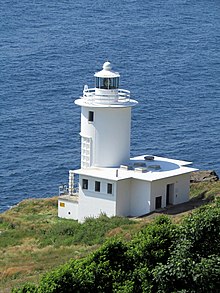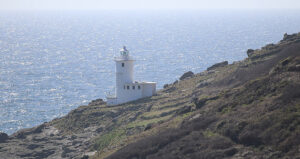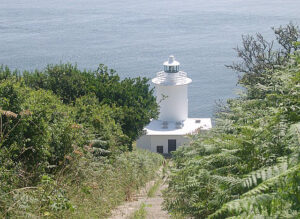
Mike McGinnes brings us the story of a unique Cornish edifice and of his involvement in its construction – the Tater-Du Lighthouse.
 (Photo: Tom Corser www.tomcorser.com. Licensed under Creative Commons Attribution-ShareAlike 3.0 Unported Licence: https://creativecommons.org/licenses/by-sa/3.0/legalcode).
(Photo: Tom Corser www.tomcorser.com. Licensed under Creative Commons Attribution-ShareAlike 3.0 Unported Licence: https://creativecommons.org/licenses/by-sa/3.0/legalcode).
The most recently erected lighthouse in Cornwall was built during 1965, on the site of a rocky coastline four miles from Penzance and two miles from Lamorna. Its construction was prompted by the wrecking of the Spanish coaster, Juan Ferrer, during October 1963, on the Runnelstone Rocks. The lighthouse, which is fully automated and painted white, consists of a rectangular building and a circular tower. A white rotating light sits near the very top of the 15 metres high tower and, being 34 metres above the mean height of the sea, it can be seen twenty miles away during the best of weather.
A red sector light warns all craft of the dangers of the Runnelstone Rocks which are a little way off the rocky shoreline from where the lighthouse is sited. When activated, a fog horn gives two blasts every twenty seconds. From the entrance to the site, the lighthouse is accessed via a steep concrete path or via the coastal foot path.
 (Photo: Tony Atkin – used under Creative Commons Attribution Share-alike license 2.0)
(Photo: Tony Atkin – used under Creative Commons Attribution Share-alike license 2.0)
My involvement began when I entered the office of the site manager responsible for building phases one and two of the new Treliske Hospital in Truro, where Humphreys Ltd were the main contractors. I was the civil engineer/site engineer there. Not only was the site manager a very clever engineer: he was also a gentleman and highly respected. He began, “We’ve picked up a contract to build a small onshore lighthouse at a place called Tater Du, about four miles from Penzance. There are some rocks there called the Runnelstone. I want you to be the engineer, get it off the ground and keep an eye on it until its completion. I’ve appointed a site manager for the project and he’s arranged the workforce, plant and equipment needed to undertake the contract. You’ll need to liaise closely with Trinity House in Penzance to agree the exact location of the building, the accurate ordnance survey levels and other site related matters. I believe you can transfer the bench mark details from a milestone situated on a neighbouring road.” He then handed me a roll of drawings and contract documents relating to the contract with the comment, “I want the contract started on the first of next month so you will have to fit it in with your requirements here. I suggest you liaise today with Trinity House and tie up a preliminary meeting with them. Keep me posted at regular intervals on your progress and that of the contract.” He smiled and said, “You’re very fortunate, many engineers would consider themselves lucky to add the building of a lighthouse to their career history”.
The Trinity House engineer was one of the most agreeable people imaginable and we got on well from the first meeting in his office. My first exercise was to transfer the ordnance level from the milestone. With the help of a chainman who carried the levelling staff while I took the dumpy level, I successfully did that. However, I was surprised how far the milestone was from the farm entrance. I transferred the ordnance datum from the entrance gate and across two fields. Then, using a theodolite, I transferred it to the base of a steep incline to the site where the lighthouse was to be built. The transfer of the datum was then checked independently by my Trinity House colleague and was found to be accurate. A high degree of accuracy was essential as the height of the various lights fitted in the lighthouse had to be in accordance with new sea charts of the area.
Apart from the distance, I also discovered a further problem on entering the two fields. I encountered a gaggle of loud, flapping geese. They appeared and charged straight at me as soon as I opened the first gate from the public road. I drove into the field, got out of my company van, quickly closed the gate and raced back to the safety of my vehicle. I then had the same situation to deal with at the second farm gate as the geese appeared to be determined to chase after me. However, I managed to complete my journey to the site.
After the temporary buildings had been erected on the upper levels of the site, the actual work on the contract began. It was first necessary to remove outcrops of rock leading down to where the lighthouse was to be built. This was to be carried out using explosives and by a local man – an explosive expert and experienced tin miner. I had worked with him before at the Treliske Hospital site where deep trenches had to be cut to enable large storm water drainage pipes to be laid. He informed me that it would take him about three days to set the charges down the steep gradient leading to where the lighthouse was to be positioned. He would drill deep into the rock which was to be removed and then prepare the holes to receive the explosive charges. When this was complete, he would then, and only then, insert the explosive charges and link them together with fuse wire. Using a burning fuse, as opposed to an electrical plunger charge, the explosions, when they took place, would ripple down the rock face from the top. If an electrical charge had been used then all the explosions would take place at the same time. The site manager ensured me that the required publicity, including the time and the date the explosions were to take place, had been given to all interested parties. All was in order.
The day of the explosions was perfect in every respect. There was little wind, a calm sea, it was sunny and warm and visibility was excellent. All those engaged with the contract, including myself and the Trinity House engineer, stood at the top of the site, away from the blast area. Red flags were raised as a precaution to all, albeit no one else was in sight. Exactly at the advertised time, the master fuse was lit. We all watched in awe as it slowly snaked its way down the slope leaving a faint trail of smoke in its wake. At that same moment, heading towards the site, from where, no one knew, came two men in an open boat. They dropped anchor between the Runnelstone Rocks and the rocky area of the coast where we were. We all shouted and waved for them to leave the area immediately. Then, one of them stood up, waved back to us, then sat down again and picked up his fishing rod.
As I said, our explosives expert had assured me that a ripple effect would take place. It did not! The effect of the charges going off was akin to the bombing of Hiroshima. We all dashed for cover as splintered rock flew in every direction and the small boat was showered with a hail of them. I believe that at that point, considering its size, the small boat with its little outboard motor, entered the Guinness Book of Records for speed at sea. In less than a minute they were out of sight.
Due to the steep slope of the rocky ground, it proved difficult to get materials down to the site and so a clever method was employed. At that time, and on bigger construction sites, mono rail systems were in use. They consisted of lengths of rail track on supporting metal frames which were quickly linked together, these could snake across reasonably level ground. On the single rail was a metal triangular shaped open carriage propelled by its own little petrol engine – it sometimes pulled another carriage behind it. To one side was a high brake handle which was easily knocked sideways when the carriage reached its destination and wooden brake shoes were used to stop it. The one-and-a-quarter cubic metre capacity carriages travelled at about three miles per hour and were designed to carry concrete, bricks, blocks or any other items that would fit into them. They could be side tipped to discharge their contents. For the site at Tater Du, such a monorail system with a single carriage was used. The track went in a straight line down the slope and the carriage was lowered down and pulled back up employing a well anchored petrol driven winch.
It was decided to let the monorail run into the building once the foundations and ground floor slab had been laid, this being for easy unloading and access of materials. It was emphasised that on no account was any person to ride on the carriage, no matter what the reason. All went well for several weeks until I had a dreaded ‘phone call telling me that the winch cable had parted and a loaded carriage had plummeted down the slope and crashed inside the building. Miraculously, no one was injured but considerable damage had been incurred.
After the monorail incident, work progressed very well due to the weather and the quality of men engaged on this particularly difficult site. I do however, recall a particular incident one very hot afternoon when I was sitting on the soft, springy, coarse grass, typical of the area, with one of our company’s foremen, sorting out some construction details. He suddenly stopped talking and said, “What do you know about adders? You know, snakes?” I looked at him and said, “Nothing at all, why, do you keep them?” He smiled slightly and said, “Don’t panic but there is one sunbathing on a flat rocky area about a metre from where you are sitting”. My reaction was immediate, I sprang to my feet to much amusement to him and watched the now disturbed snake slither away and disappear behind an outcrop of rock.
“So, we should finish at the site in ten days,” said my site manager. He was smiling and added, “I’m afraid you’re needed in Plymouth. There’s a block of flats we are building, at a place called Western Approach. It shouldn’t take you too long there, maybe a few days. There’s a change of design to an entrance foyer area where they don’t want a central column as designed but a clear span opening. Just go up there, meet the architect and sort it with his engineer.” He smiled again and said, “The official opening of the lighthouse is next week and I have given your apologies that you will be unable to attend”.
This almost unique building with all its complicated electronic fittings was handed over to Trinity House on the due date. The lighthouse was remote controlled with access for emergencies and regular maintenance only. To my knowledge, it still functions well and is a very important aid to mariners and their craft.
Finally, I can assure all small craft owners that it’s now quite safe to fish within reach of the area but to avoid the Runnelstone Rocks off Tater Du. Also, as no more explosions are scheduled to take place on or near the site, there will not be a speed challenge to beat that of the earlier small boat’s departure from the area.
 Michael McGinnes
Michael McGinnes
I came to Truro in 1961 as a young civil engineer/site engineer with the international company Humphreys Ltd who had won the contract to build Treliske Hospital. The site at that time was a green field with no buildings on it. I was based there for four and a half years as the company was awarded phases two and three of the hospital development. I acted as the engineer on several other construction sites in Devon and Cornwall during that period. With Humphreys Ltd, when my duties were no longer required at Treliske, I worked in Libya for two years, then Oman and occasionally in Pakistan. I worked for the British Government in Gibraltar for three and a quarter-years, Ascension Island, the Falklands for a year as a direct result of the invasion of the islands, and in several other foreign locations for a particular government department. Following this I was employed as a contracts manager for several years for a nationwide road building civil engineering company. My final position was with a national training organisation as a training course designer and lecturer: a company with fifty-four training centres plus outstations.
My hobbies are keeping a small holding, boating, bee keeping and tending my small flock of rare breed sheep. Being from a family of generations of mariners I have also served as a volunteer in the Royal Naval Auxiliary Service as a ship’s engineer for six years and as a member of NCI (Coastguards) for twelve years.

What an interesting story – I loved this bit ‘As I said, our explosives expert had assured me that a ripple effect would take place. It did not! The effect of the charges going off was akin to the bombing of Hiroshima. We all dashed for cover as splintered rock flew in every direction and the small boat was showered with a hail of them. I believe that at that point, considering its size, the small boat with its little outboard motor, entered the Guinness Book of Records for speed at sea. In less than a minute they were out of sight’.
That made me chuckle.
What an amazing project to work on.